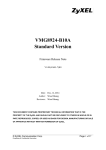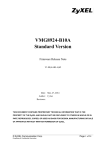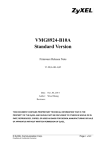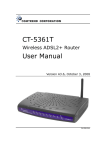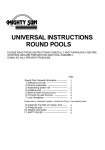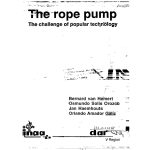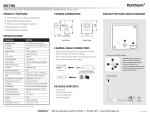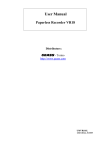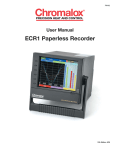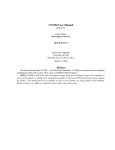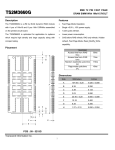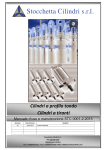Download NEC_uPD424260LE_RAM_..
Transcript
DATA SHEET MOS INTEGRATED CIRCUIT µPD42S4260, 424260 4 M-BIT DYNAMIC RAM 256 K-WORD BY 16-BIT, FAST PAGE MODE, BYTE READ/WRITE MODE Description The µ PD42S4260, 424260 are 262,144 words by 16 bits dynamic CMOS RAMs. The fast page mode and byte read/write mode capability realize high speed access and low power consumption. Besides, the µPD42S4260 can execute CAS before RAS self refresh. These are packaged in 44-pin plastic TSOP (II) and 40-pin plastic SOJ. Features • 262,144 words by 16 bits organization • Single +5.0 V ±10 % power supply • Fast access and cycle time Power consumption Active (MAX.) Part number Access time (MAX.) R/W cycle time (MIN.) Fast page mode cycle time (MIN.) µPD42S4260-60, 424260-60 880.0 mW 60 ns 110 ns 40 ns µPD42S4260-70, 424260-70 880.0 mW 70 ns 130 ns 45 ns µPD42S4260-80, 424260-80 797.5 mW 80 ns 150 ns 50 ns • The µPD42S4260 can execute CAS before RAS self refresh Refresh Power consumption at standby (MAX.) Part number Refresh cycle µPD42S4260 512 cycles / 128 ms CAS before RAS self refresh, CAS before RAS refresh, RAS only refresh, Hidden refresh 0.825 mW (CMOS level input) µPD424260 512 cycles / 8 ms CAS before RAS refresh, RAS only refresh, Hidden refresh 5.5 mW (CMOS level input) • Multiplexed address inputs ... Row address: A0 to A8, Column address: A0 to A8 The information in this document is subject to change without notice. Document No. M11089EJ5V0DSU1 1 © 1995 µ PD42S4260, 424260 Ordering Information Part number Access time (MAX.) µPD42S4260G5-60 60 ns µPD42S4260G5-70 70 ns µPD42S4260G5-80 80 ns µPD42S4260LE-60 60 ns µPD42S4260LE-70 70 ns µPD42S4260LE-80 80 ns µPD424260G5-60 60 ns µPD424260G5-70 70 ns µPD424260G5-80 80 ns µPD424260LE-60 60 ns µPD424260LE-70 70 ns µPD424260LE-80 80 ns Package 44-pin Plastic TSOP (II) (400 mil) Refresh CAS before RAS self refresh CAS before RAS refresh RAS only refresh Hidden refresh 40-pin Plastic SOJ (400 mil) 44-pin Plastic TSOP (II) (400 mil) CAS before RAS refresh RAS only refresh Hidden refresh 40-pin Plastic SOJ (400 mil) 2 µ PD42S4260, 424260 Pin Configurations (Marking Side) 44-pin Plastic TSOP (II) 40-pin Plastic SOJ (400 mil) (400 mil) 44 GND VCC 1 40 GND 2 43 I/O16 I/O1 2 39 I/O16 I/O2 3 42 I/O15 I/O2 3 38 I/O15 I/O3 4 41 I/O14 I/O3 4 37 I/O14 I/O4 5 40 I/O13 I/O4 5 36 I/O13 VCC 6 39 GND VCC 6 35 GND I/O5 7 38 I/O12 I/O5 7 34 I/O12 I/O6 8 37 I/O11 I/O6 8 33 I/O11 I/O7 9 36 I/O10 I/O7 9 32 I/O10 I/O8 10 35 I/O9 I/O8 10 NC 11 NC 13 32 NC NC 14 31 LCAS WE 15 30 UCAS RAS 16 29 OE NC 17 28 A8 A0 18 27 A7 A1 19 26 A6 A2 20 25 A5 A3 21 24 A4 VCC 22 23 GND A0 to A8 µ PD42S4260LE µ PD424260LE 1 µ PD42S4260G5 µ PD424260G5 VCC I/O1 31 I/O9 30 NC 29 LCAS 28 UCAS NC 12 WE 13 RAS 14 27 OE NC 15 26 A8 A0 16 25 A7 A1 17 24 A6 A2 18 23 A5 A3 19 22 A4 VCC 20 21 GND : Address Inputs I/O1 to I/O16 : Data Inputs/Outputs RAS : Row Address Strobe UCAS : Column Address Strobe (upper) LCAS : Column Address Strobe (lower) WE : Write Enable OE : Output Enable V CC : Power Supply GND : Ground NC : No Connection 3 µ PD42S4260, 424260 Block Diagram RAS LCAS UCAS WE Lower Byte Control Clock Generator OE Data Output Buffer Upper Byte Control VCC A0 to A8 CAS before RAS Counter Row Address Buffer Column Address Buffer X0 to X8 512 Data Input Buffer Row Decoder GND I/O1 to I/O8 (Lower Byte) Memory Cell Array 512 × 512 × 16 Data Output Buffer 512 × 16 Y0 to Y8 Sense Amplifier 512 Column Decoder I/O9 to I/O16 (Upper Byte) × 16 Data Input Buffer 4 µ PD42S4260, 424260 Input/Output Pin Functions The µ PD42S4260, 424260 have input pins RAS, CAS Note, WE, OE, A0 to A8 and input/output pins I/O1 to I/O16. Pin name Input/ Output Function RAS (Row address strobe) Input RAS activates the sense amplifier by latching a row address (A0 to A8) and selecting a corresponding word line. It refreshes memory cell array of one line selected by the row address (A0 to A8). It also selects the following function. • CAS before RAS refresh CAS (Column address strobe) Input CAS activates data input/output circuit by latching column address (A0 to A8) and selecting a digit line connected with the sense amplifier. A0 to A8 (Address input) Input 9-bit address bus. Input total 18-bit of address signal, upper 9-bit and lower 9-bit in sequence (address multiplex method). Therefore, one word (16-bit) is selected from 262,144-word by 16-bit memory cell array. In actual operation, latch row address by specifying row address and activating RAS. Then, switch the address bus to column address and activate CAS. Each address is taken into the device when RAS and CAS are activated. Therefore, the address input setup time (tASR, t ASC) and hold time (tRAH , tCAH ) are specified for the activation of RAS and CAS. WE (Write enable) Input Write control signal. Write operation is executed by activating RAS, CAS and WE. OE (Output enable) Input Read control signal. Read operation can be executed by activating RAS, CAS and OE. If WE is activated during read operation, OE is to be ineffective in the device. Therefore, read operation cannot be executed. I/O1 to I/O16 (Data input/ output) Input/ Output 16-bit data bus. I/O1 to I/O16 are used to input/output data. Note CAS means UCAS and LCAS. 5 µ PD42S4260, 424260 Electrical Specifications • CAS means UCAS and LCAS. • All voltages are referenced to GND. • After power up (VCC ≥ VCC (MIN.)), wait more than 100 µ s (RAS, CAS inactive) and then, execute eight CAS before RAS or RAS only refresh cycles as dummy cycles to initialize internal circuit. Absolute Maximum Ratings Parameter Symbol Condition Rating Unit Voltage on any pin relative to GND VT –1.0 to +7.0 V Supply voltage VCC –1.0 to +7.0 V Output current IO 50 mA Power dissipation PD 1 W Operating ambient temperature TA 0 to +70 ˚C Storage temperature Tstg –55 to +125 ˚C Caution Exposing the device to stress above those listed in Absolute Maximum Ratings could cause permanent damage. The device is not meant to be operated under conditions outside the limits described in the operational section of this specification. Exposure to Absolute Maximum Rating conditions for extended periods may affect device reliability. Recommended Operating Conditions Parameter Symbol Condition MIN. TYP. MAX. Unit 5.0 5.5 V Supply voltage VCC 4.5 High level input voltage VIH 2.4 VCC +1.0 V Low level input voltage VIL –1.0 +0.8 V Operating ambient temperature TA 0 70 ˚C MAX. Unit Capacitance (TA = 25 ˚C, f = 1 MHz) Parameter Input capacitance Data input/output capacitance Symbol Test condition MIN. TYP. CI1 Address 5 pF CI2 RAS, CAS, WE, OE 7 pF CI /O I/O 7 pF 6 µ PD42S4260, 424260 DC Characteristics Parameter Operating current Standby current µ PD42S4260 (Recommended Operating Conditions unless otherwise noted) Symbol I CC1 I CC2 Test condition RAS, CAS cycling t RC = tRC (MIN.) , IO = 0 mA MIN. MAX. Unit Notes t RAC = 60 ns 160 mA 1, 2, 3 t RAC = 70 ns 160 t RAC = 80 ns 145 RAS, CAS ≥ V IH (MIN.), I O = 0 mA 2 RAS, CAS ≥ V CC – 0.2 V, I O = 0 mA µPD424260 RAS only refresh current Operating current (Fast page mode) CAS before RAS refresh current CAS before RAS I CC3 I CC4 I CC5 I CC6 long refresh current (512 cycles / 128 ms, only for the µ PD42S4260) TYP. 0.15 RAS, CAS ≥ V IH (MIN.), I O = 0 mA 2 RAS, CAS ≥ V CC – 0.2 V, I O = 0 mA 1 RAS cycling, CAS ≥ VIH (MIN.) t RC = tRC (MIN.) , IO = 0 mA t RAC = 60 ns 160 t RAC = 70 ns 160 t RAC = 80 ns 145 t RAC = 60 ns 140 t RAC = 70 ns 140 t RAC = 80 ns 130 t RAC = 60 ns 160 t RAC = 70 ns 160 t RAC = 80 ns 145 CAS before RAS refresh: t RC = 250.0 µs RAS, CAS: VCC – 0.2 V ≤ V IH ≤ V IH(MAX.) 0V ≤ V IL ≤ 0.2 V t RAS ≤ 200 ns Standby: RAS, CAS ≥ V CC – 0.2 V Address: VIH or VIL WE, OE: VIH I O = 0 mA t RAS ≤ 1 µs RAS ≤ VIL (MAX.), CAS cycling t PC = tPC (MIN.), IO = 0 mA RAS cycling t RC = tRC (MIN.) , IO = 0 mA mA mA 1, 2, 3, 4 mA 1, 2, 5 mA 1, 2 200 µA 1, 2 300 µA 1, 2 150 µA 2 Self refresh current (CAS before RAS self refresh, only for the µPD42S4260) I CC7 RAS, CAS: tRASS = 5 ms VCC – 0.2 V ≤ VIH ≤ VIH (MAX.) 0 V ≤ VIL ≤ 0.2 V I O = 0 mA Input leakage current I I(L) VI = 0 to 5.5 V All other pins not under test = 0 V –10 +10 µA Output leakage current I O(L) VO = 0 to 5.5 V Output is disabled (Hi-Z) –10 +10 µA High level output voltage VOH I O = –2.5 mA 2.4 Low level output voltage VOL I O = +2.1 mA V 0.4 V Notes 1. ICC1 , ICC3 , ICC4 , ICC5 and ICC6 depend on cycle rates (tRC and tPC). 2. Specified values are obtained with outputs unloaded. 3. ICC1 and ICC3 are measured assuming that address can be changed once or less during RAS ≤ VIL (MAX.) and CAS ≥ V IH (MIN.). 4. ICC3 is measured assuming that all column address inputs are held at either high or low. 5. ICC4 is measured assuming that all column address inputs are switched only once during each fast page cycle. 7 µ PD42S4260, 424260 AC Characteristics (Recommended Operating Conditions unless otherwise noted) AC Characteristics Test Conditions (1) Input timing specification VIH (2) Output timing specification = 2.4 V VOH (MIN.) = 2.4 V VIL (MAX.) = 0.8 V VOL (MAX.) = 0.4 V (MIN.) tT = 5 ns tT = 5 ns (3) Output load condition VCC 1,660 Ω I/O 100 pF 590 Ω CL Common to Read, Write, Read Modify Write Cycle Parameter Symbol t RAC = 60 ns t RAC = 70 ns t RAC = 80 ns MIN. MAX. MIN. MAX. MIN. MAX. Unit Notes Read/Write cycle time t RC 110 – 130 – 150 – ns RAS precharge time tRP 40 – 50 – 60 – ns CAS precharge time t CPN 10 – 10 – 10 – ns RAS pulse width t RAS 60 10,000 70 10,000 80 10,000 ns CAS pulse width t CAS 15 10,000 20 10,000 20 10,000 ns RAS hold time t RSH 15 – 20 – 20 – ns CAS hold time t CSH 60 – 70 – 80 – ns RAS to CAS delay time tRCD 20 45 20 50 20 60 ns 2 RAS to column address delay time tRAD 15 30 15 35 15 40 ns 2 CAS to RAS precharge time t CRP 10 – 10 – 10 – ns 3 Row address setup time t ASR 0 – 0 – 0 – ns Row address hold time t RAH 10 – 10 – 10 – ns Column address setup time t ASC 0 – 0 – 0 – ns Column address hold time t CAH 15 – 15 – 15 – ns OE lead time referenced to RAS t OES 0 – 0 – 0 – ns CAS to data setup time t CLZ 0 – 0 – 0 – ns OE to data setup time tOLZ 0 – 0 – 0 – ns OE to data delay time tOED 15 – 15 – 20 – ns Masked byte write hold time referenced to RAS t MRH 0 – 0 – 0 – ns tT 3 50 3 50 3 50 ns t REF – 128 – 128 – 128 ms – 8 – 8 – 8 ms Transition time (rise and fall) Refresh time µPD42S4260 µPD424260 1 4 8 µ PD42S4260, 424260 Notes 1. In CAS before RAS refresh cycles, tRAS (MAX.) is 100 µ s. If 10 µ s < tRAS < 100 µs, RAS precharge time for CAS before RAS self refresh (tRPS) is applied. 2. For read cycles, access time is defined as follows: Input conditions Access time Access time from RAS t RAD ≤ t RAD (MAX.) and t RCD ≤ tRCD (MAX.) t RAC (MAX.) t RAC (MAX.) t RAD >t RAD (MAX.) and tRCD ≤ tRCD (MAX.) t AA (MAX.) t RAD + tAA (MAX.) t RCD > tRCD (MAX.) t CAC (MAX.) t RCD + tCAC (MAX.) tRAD (MAX.) and tRCD (MAX.) are specified as reference points only; they are not restrictive operating parameters. They are used to determine which access time (tRAC, tAA or tCAC) is to be used for finding out when output data will be available. Therefore, the input conditions tRAD ≥ tRAD (MAX.) and tRCD ≥ tRCD (MAX.) will not cause any operation problems. 3. tCRP (MIN.) requirement is applied to RAS, CAS cycles. 4. This specification is applied only to the µPD42S4260. Read Cycle Parameter Symbol t RAC = 60 ns t RAC = 70 ns t RAC = 80 ns MIN. MAX. MIN. MAX. MIN. MAX. Unit Notes Access time from RAS t RAC – 60 – 70 – 80 ns 1 Access time from CAS t CAC – 15 – 20 – 20 ns 1 Access time from column address tAA – 30 – 35 – 40 ns 1 Access time from OE t OEA – 15 – 20 – 20 ns Column address lead time referenced to RAS tRAL 30 – 35 – 40 – ns Read command setup time t RCS 0 – 0 – 0 – ns Read command hold time referenced to RAS tRRH 0 – 0 – 0 – ns 2 Read command hold time referenced to CAS tRCH 0 – 0 – 0 – ns 2 Output buffer turn-off delay time from OE tOEZ 0 15 0 15 0 20 ns 3 Output buffer turn-off delay time from CAS tOFF 0 15 0 15 0 20 ns 3 Notes 1. For read cycles, access time is defined as follows: Input conditions Access time Access time from RAS t RAD ≤ t RAD (MAX.) and t RCD ≤ tRCD (MAX.) t RAC (MAX.) t RAC (MAX.) t RAD >t RAD (MAX.) and tRCD ≤ tRCD (MAX.) t AA (MAX.) t RAD + tAA (MAX.) t RCD > tRCD (MAX.) t CAC (MAX.) t RCD + tCAC (MAX.) tRAD (MAX.) and tRCD (MAX.) are specified as reference points only; they are not restrictive operating parameters. They are used to determine which access time (tRAC, tAA or tCAC) is to be used for finding out when output data will be available. Therefore, the input conditions tRAD ≥ tRAD (MAX.) and tRCD ≥ tRCD (MAX.) will not cause any operation problems. 2. Either tRCH (MIN.) or tRRH (MIN.) should be met in read cycles. 3. tOFF (MAX.) and tOEZ (MAX.) define the time when the output achieves the condition of Hi-Z and is not referenced to VOH or VOL. 9 µ PD42S4260, 424260 Write Cycle Parameter t RAC = 60 ns t RAC = 70 ns t RAC = 80 ns MIN. MAX. MIN. MAX. MIN. MAX. Symbol Unit Notes WE hold time referenced to CAS tWCH 15 – 15 – 15 – ns 1 WE pulse width t WP 10 – 15 – 15 – ns 1 WE lead time referenced to RAS t RWL 15 – 20 – 20 – ns WE lead time referenced to CAS t CWL 15 – 15 – 20 – ns WE setup time tWCS 0 – 0 – 0 – ns OE hold time tOEH 0 – 0 – 0 – ns Data-in setup time tDS 0 – 0 – 0 – ns 3 Data-in hold time t DH 15 – 15 – 20 – ns 3 2 Notes 1. tWP (MIN.) is applied to late write cycles or read modify write cycles. In early write cycles, tWCH (MIN.) should be met. 2. If tWCS ≥ t WCS (MIN.), the cycle is an early write cycle and the data out will remain Hi-Z through the entire cycle. 3. tDS (MIN.) and tDH (MIN.) are referenced to the CAS falling edge in early write cycles. In late write cycles and read modify write cycles, they are referenced to the WE falling edge. Read Modify Write Cycle Parameter t RAC = 60 ns t RAC = 70 ns t RAC = 80 ns MIN. MAX. MIN. MAX. MIN. MAX. Symbol Unit Note Read modify write cycle time tRWC 150 – 175 – 200 – ns RAS to WE delay time tRWD 80 – 90 – 105 – ns 1 CAS to WE delay time tCWD 35 – 40 – 45 – ns 1 Column address to WE delay time tAWD 50 – 55 – 65 – ns 1 Note 1. If tWCS ≥ t WCS (MIN.), the cycle is an early write cycle and the data out will remain Hi-Z through the entire cycle. If t RWD ≥ tRWD (MIN.), tCWD ≥ tCWD (MIN.), tAWD ≥ tAWD (MIN.) and tCPWD ≥ tCPWD (MIN.), the cycle is a read modify write cycle and the data out will contain data read from the selected cell. If neither of the above conditions is met, the state of the data out is indeterminate. 10 µ PD42S4260, 424260 Fast Page Mode Parameter t RAC = 60 ns t RAC = 70 ns t RAC = 80 ns MIN. MAX. MIN. MAX. MIN. MAX. Symbol Unit Fast page mode cycle time tPC 40 – 45 – 50 – ns Access time from CAS precharge t ACP – 35 – 40 – 45 ns RAS pulse width tRASP 60 125,000 70 125,000 80 125,000 ns tCP 10 – 10 – 10 – ns RAS hold time from CAS precharge tRHCP 35 – 40 – 45 – ns Read modify write cycle time t PRWC 80 – 85 – 100 – ns CAS precharge to WE delay time t CPWD 55 – 60 – 70 – ns CAS precharge time Note 1 Note 1. If tWCS ≥ t WCS (MIN.), the cycle is an early write cycle and the data out will remain Hi-Z through the entire cycle. If t RWD ≥ tRWD (MIN.), tCWD ≥ tCWD (MIN.), tAWD ≥ tAWD (MIN.) and tCPWD ≥ tCPWD (MIN.), the cycle is a read modify write cycle and the data out will contain data read from the selected cell. If neither of the above conditions is met, the state of the data out is indeterminate. Refresh Cycle Parameter t RAC = 60 ns t RAC = 70 ns t RAC = 80 ns MIN. MAX. MIN. MAX. MIN. MAX. Symbol Unit Note CAS setup time t CSR 10 – 10 – 10 – ns CAS hold time (CAS before RAS refresh) tCHR 10 – 15 – 15 – ns RAS precharge CAS hold time t RPC 10 – 10 – 10 – ns RAS pulse width tRASS 100 – 100 – 100 – µs 1 RAS precharge time (CAS before RAS self refresh cycle) t RPS 110 – 130 – 150 – ns 1 CAS hold time (CAS before RAS self refresh cycle) t CHS –50 – –50 – –50 – ns 1 WE hold time (hidden refresh cycle) tWHR 10 – 15 – 15 – ns (CAS before RAS self refresh cycle) Note 1. This specification is applied only to the µ PD42S4260. 11 µ PD42S4260, 424260 Read Cycle tRC tRAS RAS tRP VIH – VIL – tCSH tCRP UCAS LCAS tRCD tRSH tCAS VIH – VIL – tRAD tASR Address tCPN VIH – VIL – tRAH tRAL tCAH tASC Row Col. tRCH tRCS WE tRRH VIH – VIL – tOES tOEA OE VIH – VIL – tRAC tAA tCAC tOFF tOEZ tOLZ tCLZ U I/O L I/O VOH – VOL – Hi - Z Data out Hi - Z 12 µ PD42S4260, 424260 Upper Byte Read Cycle tRC tRAS RAS tRP VIH – VIL – tCSH tCRP UCAS tRCD tRSH tCAS tCPN VIH – VIL – tCRP LCAS tMRH VIH – VIL – tRAD tASR Address VIH – VIL – tRAH tRAL tCAH tASC Row Col. tRCH tRCS WE tRRH VIH – VIL – tOES tOEA OE VIH – VIL – tRAC tAA tCAC tOFF tOEZ tOLZ tCLZ U I/O VOH – VOL – Hi - Z Data out Hi - Z Remark L I/O: Hi-Z 13 µ PD42S4260, 424260 Lower Byte Read Cycle tRC tRAS RAS tRP VIH – VIL – tCRP UCAS tMRH VIH – VIL – tCSH tCRP LCAS tRCD tRSH tCAS VIH – VIL – tRAD tASR Address tCPN VIH – VIL – tRAH tRAL tASC Row tCAH Col. tRCH tRCS WE tRRH VIH – VIL – tOES tOEA OE VIH – VIL – tRAC tAA tCAC tOFF tOEZ tOLZ tCLZ L I/O VOH – VOL – Hi - Z Data out Hi - Z Remark U I/O: Hi-Z 14 µ PD42S4260, 424260 Early Write Cycle tRC tRAS RAS tRP VIH – VIL – tCSH tRCD tCRP UCAS LCAS tRSH tCAS tCPN VIH – VIL – tRAD tASR Address VIH – VIL – WE VIH – VIL – U I/O L I/O VIH – VIL – tRAH tASC Row tCAH Col. tWCS tWCH tDS tDH Data in Remark OE: Don’t care 15 µ PD42S4260, 424260 Upper Byte Early Write Cycle tRC tRAS RAS tRP VIH – VIL – tCSH tRCD tCRP UCAS VIH – VIL – tCRP LCAS tMRH VIH – VIL – tASR Address VIH – VIL – WE VIH – VIL – tRAD tRAH tASC Row tCAH Col. tWCS tWCH tDS U I/O tCPN tRSH tCAS VIH – VIL – tDH Data in Remark OE, L I/O: Don’t care 16 µ PD42S4260, 424260 Lower Byte Early Write Cycle tRC tRAS RAS tRP VIH – VIL – tCRP UCAS tMRH VIH – VIL – tCSH tCRP LCAS tRCD tRSH tCPN tCAS VIH – VIL – tRAD tASR Address VIH – VIL – WE VIH – VIL – tRAH tASC Row tCAH Col. tWCS tWCH tDS L I/O VIH – VIL – tDH Data in Remark OE, U I/O: Don’t care 17 µ PD42S4260, 424260 Late Write Cycle tRC tRAS RAS tRP VIH – VIL – tCSH tRCD tCRP UCAS LCAS tCPN VIH – VIL – tASR Address tRSH tCAS VIH – VIL – tRAD tRAH tASC Row tCAH Col. tCWL tRWL tRCS WE tWP VIH – VIL – tOEH OE VIH – VIL – tOED U I/O L I/O VIH – VIL – Hi - Z tDS tDH Data in 18 µ PD42S4260, 424260 Upper Byte Late Write Cycle tRC tRAS RAS tRP VIH – VIL – tCSH tCRP UCAS tRCD tRSH tCAS VIH – VIL – tCRP LCAS tMRH VIH – VIL – tRAD tRAH tASR Address tCPN VIH – VIL – tASC Row tCAH Col. tCWL tRWL tRCS WE tWP VIH – VIL – tOEH OE VIH – VIL – tOED U I/O VIH – VIL – tDS tDH Hi - Z Data in Remark L I/O: Don’t care 19 µ PD42S4260, 424260 Lower Byte Late Write Cycle tRC tRAS RAS tRP VIH – VIL – tCRP UCAS tMRH VIH – VIL – tCSH tCRP LCAS tRCD VIH – VIL – tCPN tCAS VIH – VIL – tRAD tRAH tASR Address tRSH tASC Row tCAH Col. tCWL tRWL tRCS WE tWP VIH – VIL – tOEH OE VIH – VIL – tOED L I/O VIH – VIL – Hi - Z tDS tDH Data in Remark U I/O: Don’t care 20 µ PD42S4260, 424260 Read Modify Write Cycle tRWC tRAS RAS tRP VIH – VIL – tCSH tCRP UCAS LCAS tRCD tCPN tRSH tCAS VIH – VIL – tRAD tASR Address VIH – VIL – tRAH tASC Row tCAH Col. tRWD tAWD tCWD tRCS WE tCWL tRWL tWP VIH – VIL – tOEA OE VIH – VIL – tRAC tAA tCAC U I/O L I/O tOEH tOED tDS VIH – VIL – tDH Data in tOLZ tCLZ U I/O L I/O VOH – VOL – Hi - Z tOEZ Data out Hi - Z 21 µ PD42S4260, 424260 Upper Byte Read Modify Write Cycle tRWC tRAS RAS tRP VIH – VIL – tCSH tCRP UCAS tRCD tCPN tRSH tCAS VIH – VIL – tCRP LCAS tMRH VIH – VIL – tRAD tASR Address VIH – VIL – tRAH tASC Row tCAH Col. tRWD tAWD tCWD tRCS WE tCWL tRWL tWP VIH – VIL – tOEA OE VIH – VIL – tRAC tAA tCAC U I/O tOEH tOED tDS VIH – VIL – tDH Data in tOLZ tCLZ U I/O VOH – VOL – Hi - Z tOEZ Data out Hi - Z Remark In this cycle, the input data to Lower I/O is ineffective. The data out of that remains Hi-Z. 22 µ PD42S4260, 424260 Lower Byte Read Modify Write Cycle tRWC tRAS RAS tRP VIH – VIL – tCRP UCAS tMRH VIH – VIL – tCSH tCRP tRCD tCPN tRSH tCAS LCAS VIH – VIL – tRAD tASR Address VIH – VIL – tRAH tASC Row tCAH Col. tRWD tAWD tCWD tRCS WE tCWL tRWL tWP VIH – VIL – tOEA OE VIH – VIL – tRAC tAA tCAC L I/O tOEH tOED tDS VIH – VIL – tDH Data in tOLZ tCLZ L I/O VOH – VOL – Hi - Z tOEZ Data out Hi - Z Remark In this cycle, the input data to Upper I/O is ineffective. The data out of that remains Hi-Z. 23 µ PD42S4260, 424260 Fast Page Mode Read Cycle tRASP RAS VIH – VIL – tCSH tCRP UCAS LCAS tRCD tRSH tCAS tPC tCAS tCP tCAS tCP tCPN VIH – VIL – tASR Address tRP tRHCP VIH – VIL – tRAD tRAH tASC Row tCAH tASC Col. tRAL tCAH tASC tCAH Col. Col. tRCH tRCS WE tRCH tRCS tRCH tRCS tRRH VIH – VIL – tOES tACP OE tOEA tOLZ tOEA tOLZ VIH – VIL – tOEZ tRAC tAA tCAC tCLZ U I/O L I/O VOH – VOL – Hi - Z tACP tOFF Data out tOEA tOLZ tOEZ tAA tCAC tCLZ Hi - Z tOFF Data out tAA tCAC tCLZ Hi - Z tOFF tOEZ Data out Hi - Z Remark In the fast page mode, read, write and read modify write cycles are available for each of the consecutive CAS cycles within the same RAS cycle. 24 µ PD42S4260, 424260 Fast Page Mode Byte Read Cycle tRP tRASP RAS tRHCP VIH– VIL– tPC tCSH tCRP UCAS tRCD tCP tRAD tRAH tASC VIH– VIL– Row tCAH tASC Col. tCP tCAH tMRH tRCH tRAL tCAH tASC Col. tRCS WE tCAS VIH– VIL– tASR Address tCPN VIH– VIL– tCRP LCAS tRSH tCAS tCAS Col. tRCS tRCH tRCH tRCS tRRH VIH– VIL– tOES tACP OE tOEA tOLZ VIH– VIL– tOEA tOLZ tRAC tAA tCAC tCLZ U I/O VOH– VOL– tACP tOEZ tAA tCAC tCLZ tOFF Hi - Z VOH– VOL– tOFF tOEZ Hi - Z Hi - Z Data out Data out tAA tCAC tCLZ L I/O tOEA tOLZ tOEZ tOFF Hi - Z Hi - Z Data out Remarks 1. In the fast page mode, read, write and read modify write cycles are available for each of the consecutive CAS cycles within the same RAS cycle. 2. This cycle can be used to control either UCAS or LCAS only. Or, it can be used to control UCAS or LCAS simultaneously, or at random. 25 µ PD42S4260, 424260 Fast Page Mode Early Write Cycle tRASP tRP tRHCP VIH – RAS VIL – tPC tCSH tCRP tRCD tCAS tCAS tCP tRSH tCAS tCP tCPN UCAS VIH – LCAS VIL – tASR Address VIH – VIL – tRAD tRAH tASC Row tCAH tASC Col. tCAH tASC Col. tWCS tWCH tWCS tDS tDH tDS tRAL tCAH Col. tWCH tWCS tWCH tDH tDS tDH WE VIH – VIL – U I/O VIH – L I/O VIL – Data in Data in Data in Remarks 1. OE: Don’t care 2. In the fast page mode, read, write and read modify write cycles are available for each of the consecutive CAS cycles within the same RAS cycle. 26 µ PD42S4260, 424260 Fast Page Mode Byte Early Write Cycle tRP tRASP RAS tRHCP VIH– VIL– tCSH tCRP UCAS tPC tRCD tCP tCAS tCP tMRH VIH– VIL– tASR Address tCPN VIH– VIL– tCRP LCAS tRSH tCAS tCAS VIH– VIL– tRAD tRAH tASC Row tCAH tASC Col. tCAH tASC Col. tWCS tWCH tDS tDH tWCS tWCH tRAL tCAH Col. tWCS tWCH VIH– WE VIL– U I/O VIH– VIL– tDS Data in Data in tDS L I/O VIH– VIL– tDH tDH Data in Remarks 1. OE: Don’t care 2. In the fast page mode, read, write and read modify write cycles are available for each of the consecutive CAS cycles within the same RAS cycle. 3. This cycle can be used to control either UCAS or LCAS only. Or, it can be used to control UCAS or LCAS simultaneously, or at random. 27 µ PD42S4260, 424260 Fast Page Mode Late Write Cycle tRASP tRP tRHCP RAS VIH – VIL – tPC tCSH tCRP tRCD tCAS tCP tCAS tRSH tCAS tCP tCPN UCAS VIH – LCAS VIL – tRAD tASR Address VIH – VIL – tRAH tASC Row tCAH tASC Col. tCAH Col. tCWL tRCS tWP tRAL tCAH tASC Col. tCWL tRWL tWP tCWL tRCS tWP tRCS WE VIH – VIL – tOEH OE tOEH tOEH VIH – VIL – tOED U I/O VIH – L I/O VIL – Hi - Z tDS tDH Data in tOED Hi - Z tDS tDH Data in tOED Hi - Z tDS tDH Data in Remark In the fast page mode, read, write and read modify write cycles are available for each of the consecutive CAS cycles within the same RAS cycle. 28 µ PD42S4260, 424260 Fast Page Mode Byte Late Write Cycle tRP tRASP tRHCP RAS VIH– VIL– UCAS tPC tCSH tCRP tRCD tCP tCAS tCP tMRH VIH– VIL– tRAD tASR Address VIH– VIL– tRAH tASC Row tASC tCAH Col. tCAH tRCS tWP tRCS tWP tRCS tWP tOEH tOEH VIH– VIL– VIH– VIL– Hi - Z VIH– VIL– Hi - Z tDS tDH Data in tOED L I/O tCWL tRWL VIH– VIL– tOED U I/O Col. tCWL tOEH OE tRAL tCAH tASC Col. tCWL WE tCPN VIH– VIL– tCRP LCAS tRSH tCAS tCAS tOED tOED Hi - Z tOED Hi - Z tDS Hi - Z tDH Data in tDS tDH Data in tOED Hi - Z Remarks 1. In the fast page mode, read, write and read modify write cycles are available for each of the consecutive CAS cycles within the same RAS cycle. 2. This cycle can be used to control either UCAS or LCAS only. Or, it can be used to control UCAS or LCAS simultaneously, or at random. 29 µ PD42S4260, 424260 Fast Page Mode Read Modify Write Cycle tRASP tRP RAS VIH – VIL – tCRP UCAS LCAS tPRWC tCAS tRCD tCAS tCP tCAS tCPN VIH – VIL – tRAL tRAD tASR tRAH tASC Address tCP VIH – VIL – Row tCAH tASC Col. Col. Col. tACP tRWD tAWD tCWD tRCS tASC tCAH tCAH tCWL tWP tACP tCPWD tAWD tCWD tRCS tCWL tWP tRCS tCPWD tAWD tCWD tCWL tRWL tWP VIH – WE VIL – tRAC tAA tAA tOEH tCAC tOEA OE VIH – VIL – tCLZ tOLZ U I/O VOH – L I/O VOL – Hi - Z tOED tCLZ tOEZ tOLZ Hi - Z out tDH in tOEH tCAC tOEA tDS U I/O VIH – L I/O VIL – tAA tOEH tCAC tOEA tOED tCLZ tOEZ tOLZ Hi - Z out tDS tDH in tOED tOEZ Hi - Z out tDS tDH in Remark In the fast page mode, read, write and read modify write cycles are available for each of the consecutive CAS cycles within the same RAS cycle. 30 µ PD42S4260, 424260 Fast Page Mode Byte Read Modify Write Cycle tRP tRASP RAS VIH– VIL– tCRP UCAS tPRWC tCAS tRCD VIH– VIL– tCRP LCAS tCAS tCP tCP tMRH VIH– VIL– tRAD tRAL tCAH tASR tRAH tASC Address VIH– VIL– Row tASC Col. tCAH tASC Col. tCAH Col. tACP tRWD tAWD tCWD tRCS WE tWP tACP tCPWD tAWD tCWD tCWL tRCS tCWL tWP tRCS tCPWD tAWD tCWD tCWL tRWL tWP VIH– VIL– tRAC tAA VIH– VIL– tOEA tCLZ tOLZ U I/O VOH– VOL– Hi - Z L I/O VOH– VOL– Hi - Z tOEH tCAC tCAC tOED tCLZ tOEZ tOLZ tCLZ tOED tOLZ tOEZ Hi - Z out tOEH tOEA tOEA tOED tOEZ Hi - Z out Hi - Z out tDS VIH– U I/O VIL– tAA tAA tOEH tCAC OE tCPN tCAS tDS tDH tDH in in tDS VIH– L I/O VIL– tDH in Remarks 1. In the fast page mode, read, write and read modify write cycles are available for each of the consecutive CAS cycles within the same RAS cycle. 2. This cycle can be used to control either UCAS or LCAS only. Or, it can be used to control UCAS or LCAS simultaneously, or at random. 31 µ PD42S4260, 424260 CAS Before RAS Self Refresh Cycle (Only for the mPD42S4260) tRASS RAS tRPS VIH – VIL – tCRP tRPC tCHS UCAS LCAS VIH – VIL – tCPN t CSR Remark Address, WE, OE: Don't care L I/O, U I/O: Hi-Z Cautions on Use of CAS Before RAS Self Refresh CAS before RAS self refresh can be used independently when used in combination with distributed CAS before RAS long refresh; However, when used in combination with burst CAS before RAS long refresh or with long RAS only refresh (both distributed and burst), the following cautions must be observed. (1) Normal Combined Use of CAS Before RAS Self Refresh and Burst CAS Before RAS Long Refresh When CAS before RAS self refresh and burst CAS before RAS long refresh are used in combination, please perform CAS before RAS refresh 512 times within an 8 ms interval just before and after setting CAS before RAS self refresh. (2) Normal Combined Use of CAS Before RAS Self Refresh and Long RAS Only Refresh When CAS before RAS self refresh and RAS only refresh are used in combination, please perform RAS only refresh 512 times within an 8 ms interval just before and after setting CAS before RAS self refresh. (3) If tRASS (MIN.) is not satisfied at the beginning of CAS before RAS self refresh cycles (tRAS < 100 µ s), CAS before RAS refresh cycles will be executed one time. If 10 µ s < tRAS < 100 µs, RAS precharge time for CAS before RAS self refresh (tRPS) is applied. And refresh cycles (512/128 ms) should be met. For details, please refer to How to use DRAM User’s Manual. 32 µ PD42S4260, 424260 CAS Before RAS Refresh Cycle tRC tRC tRAS RAS tRP tRAS tRP VIH – VIL – tCRP tCSR tCHR tRPC tCSR tCHR tRPC tCPN UCAS VIH – LCAS VIL – Remark Address, WE, OE: Don’t care L I/O, U I/O: Hi-Z RAS Only Refresh Cycle tRC tRAS RAS tRC tRP tRAS tRP VIH – VIL – tCRP tCRP UCAS LCAS tRPC VIH – VIL – tASR Address tCPN VIH – VIL – tRAH Row Remark WE, OE: Don’t care tASR tRAH Row L I/O, U I/O: Hi-Z 33 µ PD42S4260, 424260 Hidden Refresh Cycle (Read) tRC tRC tRAS RAS tRSH tRCD tASR tCHR tCPN VIH – VIL – tRAH tRAL tASC Row tCAH Col. tRCS WE tRP VIH – VIL – tRAD Address tRAS VIH – VIL – tCRP UCAS LCAS tRP tWHR VIH – VIL – tOES OE tOEA VIH – VIL – tRAC tAA tCAC tOLZ tCLZ U I/O L I/O VOH – VOL – Hi - Z tOFF tOEZ Data Out Hi - Z 34 µ PD42S4260, 424260 Hidden Refresh Cycle (Write) tRC tRC tRAS RAS tRP VIH – VIL – tCRP UCAS LCAS tRAS tRP tRSH tRCD tCHR tCPN VIH – VIL – tRAD tASR Address VIH – VIL – tRAH tCAH tASC Row Col. tWCS WE tWCH VIH – VIL – tDS U I/O L I/O VIH – VIL – Remark OE: tDH Data in Don’t care 35 µ PD42S4260, 424260 Package Drawings 44 PIN PLASTIC TSOP(II) (400 mil) 44 23 1 P E F detail of lead end 22 A H I K G J N C D M B L M NOTE Each lead centerline is located within 0.13 mm (0.005 inch) of its true position (T.P.) at maximum material condition. ITEM MILLIMETERS INCHES A 18.63 MAX. 0.734 MAX. B 0.93 MAX. 0.037 MAX. C 0.8 (T.P.) 0.031 (T.P.) D 0.32 +0.08 –0.07 0.013±0.003 E 0.1±0.05 0.004±0.002 F 1.2 MAX. 0.048 MAX. G 0.97 0.038 H 11.76±0.2 0.463±0.008 I 10.16±0.1 0.400±0.004 J 0.8±0.2 0.031 +0.009 –0.008 K 0.145 +0.025 –0.015 0.006±0.001 L 0.5±0.1 0.020 +0.004 –0.005 M 0.13 0.005 N 0.10 0.004 P 3° +7° –3° 3° +7° –3° S44G5-80-7JF4 36 µ PD42S4260, 424260 40 PIN PLASTIC SOJ (400 mil) 21 1 20 F E T I H G U J C 40 D B Q K M N P M NOTE Each lead centerline is located within 0.12 mm (0.005 inch) of its true position (T.P.) at maximum material condition. ITEM MILLIMETERS INCHES B 26.29 +0.2 –0.35 1.035+0.008 –0.014 C 10.16 0.400 D 11.18±0.2 0.440±0.008 E 1.08±0.15 0.043 +0.006 –0.007 F 0.7 0.028 G 3.5±0.2 0.138±0.008 H 2.4±0.2 0.094+0.009 –0.008 I 0.8 MIN. 0.031 MIN. J 2.6 0.102 K 1.27(T.P.) 0.050(T.P.) M 0.40±0.10 0.016 +0.004 –0.005 N 0.12 0.005 P 9.40±0.20 0.370±0.008 Q T 0.15 R0.85 0.006 R0.033 U 0.20 +0.10 –0.05 0.008 +0.004 –0.002 P40LE-400A-2 37 µ PD42S4260, 424260 Recommended Soldering Conditions The following conditions (see tables below and next page) must be met when soldering µ PD42S4260, 424260. For more details, refer to our document “SEMICONDUCTOR DEVICE MOUNTING TECHNOLOGY MANUAL” (IEI-1207). Please consult with our sales offices in case other soldering process is used, or in case the soldering is done under different conditions. Types of Surface Mount Device µ PD42S4260G5, 424260G5: 44-pin plastic TSOP (II) (400 mil) Soldering process Soldering conditions Peak temperature of package surface: 235 ˚C or lower, Reflow time: 30 seconds or less (210 ˚C or higher), Number of reflow processes: MAX. 2 Exposure limit: 7 daysNote (10 hours pre-baking is required at 125 ˚C afterwards) Infrared ray reflow Symbol IR35-107-2 Cautions 1. After the first reflow process, cool the package down to room temperature, then start the second reflow process. 2. After the first reflow process, do not use water to remove residual flux (water can be used in the second process). Peak temperature of package: 215 ˚C or lower, Reflow time: 40 seconds or less (200 ˚C or higher), Number of reflow processes: MAX. 2 Exposure limit: 7 daysNote (10 hours pre-baking is required at 125 ˚C afterwards) VPS VP15-107-2 Cautions 1. After the first reflow process, cool the package down to room temperature, then start the second reflow process. 2. After the first reflow process, do not use water to remove residual flux (water can be used in the second process). Partial heating method Note Terminal temperature: 300 ˚C or lower, Time: 3 seconds or less (Per side of the package). — Exposure limit before soldering after dry-pack package is opened. Storage conditions: 25 ˚C and relative humidity at 65 % or less. Caution Do not apply more than one soldering method at any one time, except for “Partial heating method”. 38 µ PD42S4260, 424260 µ PD42S4260LE, 424260LE: 40-pin plastic SOJ (400 mil) Soldering process Soldering conditions Peak temperature of package surface: 235 ˚C or lower, Reflow time: 30 seconds or less (210 ˚C or higher), Number of reflow processes: MAX. 2 Exposure limit: 7 daysNote (20 hours pre-baking is required at 125 ˚C afterwards) Infrared ray reflow Symbol IR35-207-2 Cautions 1. After the first reflow process, cool the package down to room temperature, then start the second reflow process. 2. After the first reflow process, do not use water to remove residual flux (water can be used in the second process). Peak temperature of package: 215 ˚C or lower, Reflow time: 40 seconds or less (200 ˚C or higher), Number of reflow processes: MAX. 2 Exposure limit: 7 daysNote (20 hours pre-baking is required at 125 ˚C afterwards) VPS VP15-207-2 Cautions 1. After the first reflow process, cool the package down to room temperature, then start the second reflow process. 2. After the first reflow process, do not use water to remove residual flux (water can be used in the second process). Partial heating method Note Terminal temperature: 300 ˚C or lower, Time: 3 seconds or less (Per side of the package). — Exposure limit before soldering after dry-pack package is opened. Storage conditions: 25 ˚C and relative humidity at 65 % or less. Caution Do not apply more than one soldering method at any one time, except for “Partial heating method”. 39







































